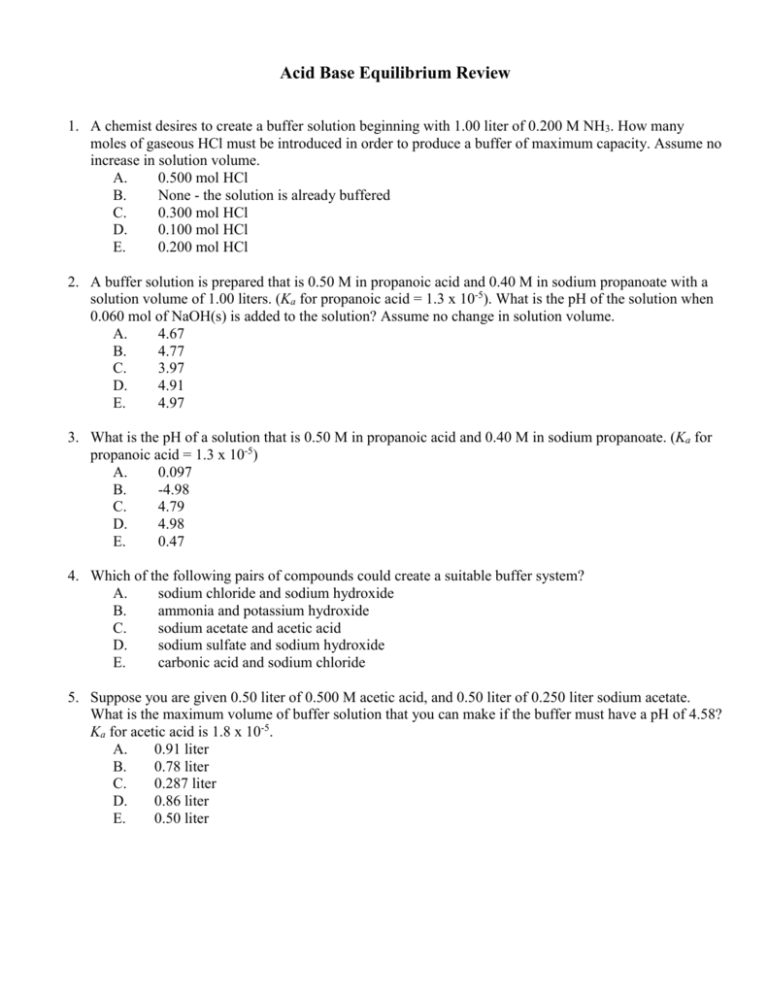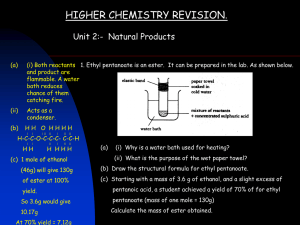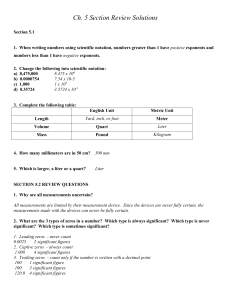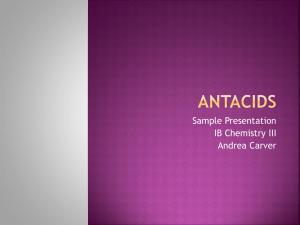Acid Base Equilibrium Review
advertisement

Acid Base Equilibrium Review 1. A chemist desires to create a buffer solution beginning with 1.00 liter of 0.200 M NH3. How many moles of gaseous HCl must be introduced in order to produce a buffer of maximum capacity. Assume no increase in solution volume. A. 0.500 mol HCl B. None - the solution is already buffered C. 0.300 mol HCl D. 0.100 mol HCl E. 0.200 mol HCl 2. A buffer solution is prepared that is 0.50 M in propanoic acid and 0.40 M in sodium propanoate with a solution volume of 1.00 liters. (Ka for propanoic acid = 1.3 x 10-5). What is the pH of the solution when 0.060 mol of NaOH(s) is added to the solution? Assume no change in solution volume. A. 4.67 B. 4.77 C. 3.97 D. 4.91 E. 4.97 3. What is the pH of a solution that is 0.50 M in propanoic acid and 0.40 M in sodium propanoate. (Ka for propanoic acid = 1.3 x 10-5) A. 0.097 B. -4.98 C. 4.79 D. 4.98 E. 0.47 4. Which of the following pairs of compounds could create a suitable buffer system? A. sodium chloride and sodium hydroxide B. ammonia and potassium hydroxide C. sodium acetate and acetic acid D. sodium sulfate and sodium hydroxide E. carbonic acid and sodium chloride 5. Suppose you are given 0.50 liter of 0.500 M acetic acid, and 0.50 liter of 0.250 liter sodium acetate. What is the maximum volume of buffer solution that you can make if the buffer must have a pH of 4.58? Ka for acetic acid is 1.8 x 10-5. A. 0.91 liter B. 0.78 liter C. 0.287 liter D. 0.86 liter E. 0.50 liter 6. The image above shows the titration of a: A. strong acid with a strong base B. weak base with a strong base C. Weak acid with a strong acid D. Strong acid with a weak base E. Weak acid with a strong base 7. A buffer solution is prepared that is 0.50 M in propanoic acid and 0.40 M in sodium propanoate with a solution volume of 1.00 liters. (Ka for propanoic acid = 1.3 x 10-5). What is the pH of the solution when 0.040 mol of HCl(g) is added to the solution? Assume no change in solution volume. A. 4.71 B. 4.87 C. 4.91 D. 4.78 E. 5.06 8. The Ksp of BaSO4 is 1.5 x 10-9. What is the molar concentration of Ba2+(aq) in a saturated solution of BaSO4? A. 6.7 x 10-15 M B. 1.7 x 10-2 M C. 2.45 x 10-5 M D. 3.9 x 10-5 M E. 2.25 x 10-18 M 9. Suppose that 0.250 liters of a buffer solution that contains 0.225 M acetic acid and 0.225 M sodium acetate. What would be the pH change if 30.0 mL of 0.100 M HCl is added to this buffer? Assume volumes are additive. Ka for acetic acid is 1.8 x 10 -5. A. 5.40 to 7.68 B. 4.70 to 4.78 C. 4.74 to 4.70 D. 6.40 to 4.56 E. 4.74 to 4.82 10. 80.0 mL of a buffer solution contains 0.169 M NH3 and 0.183 M NH4Cl. If you add 10.0 mL of 0.100 M HCl, what will be the pH? Kb = 1.81 x 10-5. Assume additive volumes. A. 8.985 B. 7.908 C. 10.309 D. 9.161 E. 9.223 11. Ka for HNO2 is 4.5 x 10-4, calculate the pH of a buffer solution made by mixing 0.225 mol of HNO2 and 0.450 mol of NaNO2 in enough water to make 0.400 liter of solution. A. 3.51 B. 3.65 C. 2.98 D. 3.90 E. 5.72 12. 50.0 mL of 0.100 M NH3 is titrated with 0.025 M HCl. What is the pH of the solution after 100.0 mL of HCl has been added? Kb for NH3 1.81 x 10-5. A. 4.74 B. 8.99 C. 12.45 D. 9.26 E. 10.90 13. The Ksp of BaSO4 is 1.5 x 10-9. How many grams of BaSO4 can be dissolved in 1000. liters of solution? A. 170 g B. 9.1 g C. 39 g D. 2.3 g E. 0.085 g 14. Calculate the Ksp of Ba(OH)2 given the fact that the solubility of Ba(OH)2 in water is 4.6 g per 0.250 liter. A. 1.5 x 10-4 B. 1.1 x 10-1 C. 1.2 x 10-2 D. 2.0 x 10-7 E. 4.9 x 10-3 15. What is the pH of a buffer solution consisting of 0.150 mol of NH3 plus 0.250 mol of NH4Cl in enough water to make 0.750 liter of solution. Kb = 1.81 x 10-5. A. 2.721 B. 8.547 C. 4.963 D. 9.038 E. 11.279 16. 200.0 mL of 0.200 M HCl is titrated with 0.050 M NaOH. What is the pH after the addition of 100. mL of the NaOH solution? A. 0.93 B. 0.76 C. 1.03 D. 0.82 E. 1.45 17. 2005 A Required HC3H5O2(aq) ↔ C3H5O2–(aq) + H+(aq) Ka = 1.3410–5 Propanoic acid, HC3H5O2, ionizes in water according to the equation above. (a) Write the equilibrium constant expression for the reaction. (b) Calculate the pH of a 0.265 M solution of propanoic acid. (c) A 0.496 g sample of sodium propanoate, NaC3H5O2, is added to a 50.0 mL sample of a 0.265 M solution of propanoic acid. Assuming that no change in the volume of the solution occurs, calculate each of the following. (i) The concentration of the propanoate ion, C3H5O2–(aq) in the solution (ii) The concentration of the H+(aq) ion in the solution. The methanoate ion, HCO2–(aq) reacts with water to form methanoic acid and hydroxide ion, as shown in the following equation. HCO2–(aq) + H2O (l) ↔ HCO2(aq) + OH–(aq) (d) Given that [OH–] is 4.1810–6 M in a 0.309 M solution of sodium methanoate, calculate each of the following. (i) The value of Kb for the methanoate ion, HCO2–(aq) (ii) The value of Ka for methanoic acid, HCO2H (e) Which acid is stronger, propanoic acid or methanoic acid? Justify your answer. Answer: [C3H5O2–][H+] (a) [HC H O ] = Ka 3 5 2 (b) let X be the amount of acid that ionizes, then X = [C3H5O2–] = [H+] 0.265 – X = [HC3H5O2] X2 –5 0.265–X = Ka = 1.3410 X= 0.00188 M = [H+] [you can assume that 0.265 – X ≈ 0.265 in order to simplify your calculations] pH = –log[H+] = 2.73 1 mol 0.496 g 96.0 g (c) (i) = 0.103 M 0.050 L since each sodium propanoate dissociates completely when dissolved, producing 1 propanoate ion for every sodium propanoate, and this is over 1000’s of times larger than the propanoate ions from the acid, then [C3H5O2–] = 0.103 M (ii) let X be the amount that ionizes, then: X = [H+] X + 0.103 = [C3H5O2–] 0.265 – X = [HC3H5O2] (X)(0.103+X) = Ka = 1.3410–5 0.265–X X= 3.4310–5 M = [H+] [you can assume that 0.265 – X ≈ 0.265 and X + 0.103 ≈ 0.103, in order to simplify your calculations] (d) (i) [HCO2] = [OH–] = 4.1810–6 M [HCO2–] = 0.309 - 4.1810–6 [HCO2][OH–] (4.1810–6)2 Kb = = = [HCO2–] (0.309 - 4.1810–6) = 5.6510–11 Kw 110–14 (ii) Ka = K = = 1.7710–4 5.6510–11 b (e) methanoic acid is stronger; the larger the Ka, the stronger the acid OR for monoprotic organic acids, the longer the carbon chain, the weaker the acid. Propanoic has 3 carbons, whereas, methanoic has only 1.








